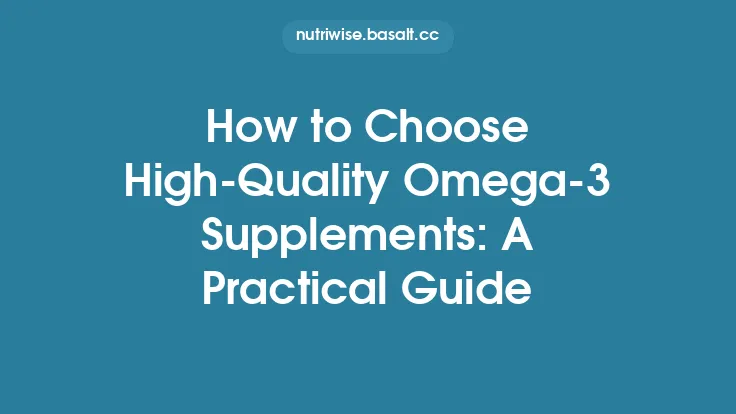Choosing a high‑quality vitamin supplement can feel overwhelming, especially with the sheer number of products lining pharmacy shelves and online storefronts. While the promise of “boosted immunity,” “enhanced energy,” or “optimal wellness” is enticing, the reality is that not all supplements are created equal. This guide walks you through the essential criteria to evaluate when selecting a vitamin product, empowering you to make an informed decision that aligns with your health goals, safety standards, and budget.
Understanding Supplement Labels
A clear, accurate label is the first line of defense against low‑quality products. Here’s what to look for:
- Active Ingredient Amount: The label should list the exact amount of each vitamin per serving, expressed in milligrams (mg), micrograms (µg), or International Units (IU) where appropriate. Compare this to the Recommended Dietary Allowance (RDA) or Adequate Intake (AI) for your age and sex to ensure the dosage is neither sub‑therapeutic nor excessive.
- Form of the Vitamin: Different chemical forms have varying absorption rates. For example, certain forms of vitamin C, vitamin A, or vitamin K are more bioavailable than others. The label should specify the exact form (e.g., “ascorbic acid” vs. “sodium ascorbate”).
- Other Ingredients: Examine the “inactive” or “other” ingredients list. Look for unnecessary fillers, artificial colors, sweeteners, or allergens. Commonly used excipients such as magnesium stearate, silicon dioxide, or cellulose are generally safe, but excessive amounts can affect absorption.
- Serving Size and Servings per Container: Verify how many capsules, tablets, or powders constitute a single serving and how many servings you’ll receive per container. This helps you calculate the true cost per dose.
- Expiration Date: Vitamins are sensitive to heat, light, and moisture. An expiration date ensures potency; avoid products that are close to or past this date.
Evaluating Ingredient Quality and Purity
The source and processing of raw materials dramatically influence supplement quality.
- Sourcing: High‑quality manufacturers often disclose whether vitamins are derived from natural sources (e.g., plant extracts) or synthesized chemically. While both can be effective, natural sources may contain co‑factors that aid absorption.
- Purity Standards: Look for statements indicating the product is “free from heavy metals, pesticides, and microbial contaminants.” Some brands provide a Certificate of Analysis (CoA) that details testing results for contaminants such as lead, arsenic, mercury, and cadmium.
- Additive Transparency: Avoid products that hide proprietary blends without disclosing individual ingredient amounts. This lack of transparency can mask sub‑optimal dosages or the presence of low‑quality fillers.
Assessing Bioavailability and Formulations
Bioavailability refers to the proportion of a nutrient that is absorbed and utilized by the body. Several factors affect this:
- Chemical Form: Certain vitamin forms are inherently more absorbable. For instance, methylated forms of B‑vitamins (e.g., methylcobalamin) are generally better utilized than their non‑methylated counterparts. While this guide does not focus on specific vitamins, the principle applies across the board.
- Delivery System: Liposomal encapsulation, softgel capsules, and chewable tablets can enhance absorption compared to standard tablets. Liposomal technology, for example, encases the vitamin in a phospholipid layer that merges with cell membranes, facilitating direct delivery.
- Synergistic Ingredients: Some formulations include cofactors that aid absorption (e.g., a small amount of a fat source to improve uptake of fat‑soluble vitamins). Check whether the product includes such synergists and whether they are present in effective amounts.
Third‑Party Testing and Certification
Independent verification is a hallmark of trustworthy supplements.
- USP (United States Pharmacopeia): The USP Verified Mark indicates that the product meets strict standards for potency, purity, and manufacturing practices.
- NSF International: NSF certification confirms that the supplement contains what the label claims and is free from harmful contaminants.
- ConsumerLab: While not a certification, ConsumerLab conducts comprehensive testing and publishes results. Products that pass their testing are often highlighted on the label or website.
- Informed‑Choice/Informed‑Sport: These programs test for banned substances, which is especially relevant for athletes.
When a product bears any of these marks, you can be more confident that it has undergone rigorous, unbiased testing.
Manufacturing Standards and Good Practices
The environment in which a supplement is produced matters as much as the ingredients themselves.
- cGMP (Current Good Manufacturing Practices): Facilities that follow cGMP guidelines adhere to FDA‑mandated standards for cleanliness, equipment calibration, and documentation. Look for statements such as “manufactured in a cGMP‑certified facility.”
- Facility Audits: Reputable brands often undergo regular third‑party audits. Some even publish audit reports or summaries on their websites.
- Batch Numbers: A visible batch or lot number allows you to trace the product back to a specific production run, which is crucial for recall situations.
Dosage Accuracy and Recommended Daily Allowances
Even a high‑quality supplement can be problematic if the dosage is inappropriate.
- Alignment with RDA/AI: Ensure the supplement’s dosage aligns with established dietary guidelines for your demographic. Excessive intake of certain vitamins can lead to toxicity (e.g., hypervitaminosis A or D), while insufficient amounts may render the product ineffective.
- Tolerable Upper Intake Level (UL): The UL represents the maximum daily intake unlikely to cause adverse effects. A well‑formulated supplement should stay comfortably below this threshold unless prescribed by a healthcare professional.
- Adjustable Dosing: Some products offer flexible dosing (e.g., “take 1–2 capsules daily”) to accommodate individual needs. While flexibility can be beneficial, it also places responsibility on the consumer to determine the appropriate dose.
Potential Interactions and Safety Considerations
Vitamins can interact with medications, health conditions, and other nutrients.
- Medication Interactions: Certain vitamins can affect the metabolism of prescription drugs (e.g., vitamin K and anticoagulants). Even though this guide does not delve into specific vitamins, the principle remains: always verify potential interactions with your healthcare provider.
- Health Conditions: Individuals with renal, hepatic, or metabolic disorders may require adjusted dosages or avoid certain forms of vitamins altogether.
- Allergen Awareness: Check for common allergens such as soy, gluten, dairy, or shellfish, especially if you have known sensitivities.
Shelf Life, Storage, and Packaging
Proper storage preserves potency and prevents degradation.
- Packaging Materials: Dark, airtight containers protect vitamins from light and oxygen, both of which can degrade sensitive nutrients. Blister packs also limit exposure to moisture.
- Storage Conditions: Most vitamins should be stored in a cool, dry place away from direct sunlight. Some formulations, particularly those containing oils, may require refrigeration.
- Stability Claims: Some manufacturers provide stability data indicating that the product retains a certain percentage of potency after a defined period. Look for such claims if you plan to store the supplement for an extended time.
Cost vs. Value: What to Expect
Price alone is not a reliable indicator of quality, but it can reflect certain aspects of production.
- Ingredient Sourcing: Premium raw materials and rigorous testing increase costs. Extremely low‑priced supplements may cut corners on purity or bioavailability.
- Quantity per Dose: A higher price per capsule does not necessarily mean better value if the dosage is excessive or insufficient. Calculate the cost per active milligram to compare products objectively.
- Long‑Term Savings: Investing in a high‑quality supplement can reduce the need for additional products (e.g., separate antioxidants) and may lower healthcare costs by supporting overall health.
Questions to Ask Your Healthcare Provider
Before adding any supplement to your regimen, a brief conversation with a qualified professional can prevent missteps.
- Is supplementation necessary for me based on my diet and health status?
- Which form of the vitamin would be most appropriate for my needs?
- Are there any medications or conditions that could interact with the supplement?
- What dosage aligns with my individual requirements?
- Should I monitor any biomarkers (e.g., blood levels) while taking the supplement?
Final Thoughts
Selecting a high‑quality vitamin supplement is a multi‑step process that blends label literacy, ingredient scrutiny, manufacturing transparency, and personal health considerations. By focusing on:
- Clear, accurate labeling
- Verified purity and sourcing
- Proven bioavailability and appropriate formulation
- Independent third‑party testing
- Adherence to cGMP and other manufacturing standards
- Dosage that aligns with established dietary guidelines
- Awareness of potential interactions and storage requirements
you can confidently choose a product that truly supports your nutritional goals. Remember, supplements are meant to complement—not replace—a balanced diet and healthy lifestyle. When in doubt, always seek guidance from a healthcare professional to tailor supplementation to your unique needs.





